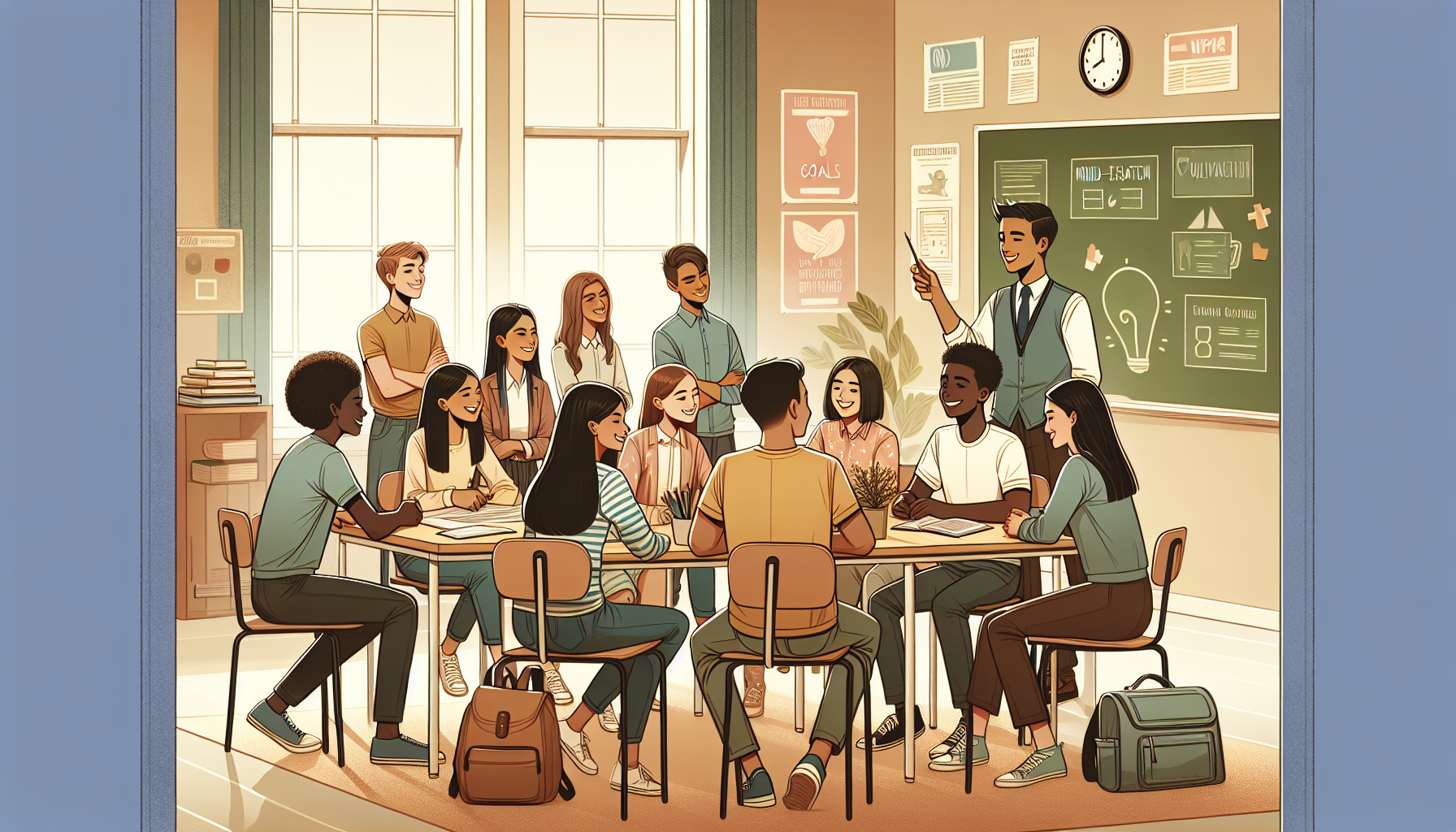It’s never easy keeping students engaged, is it? Whether you’re dealing with wandering eyes or quiet classrooms, the struggle is real. Finding effective techniques to capture attention and enthusiasm can feel like searching for a needle in a haystack.
But don’t worry, I’ve got your back! If you stick around, I’ll share some tried-and-true strategies for boosting student engagement. You’ll discover everything from active learning to gamification, all designed to make your classroom buzz with energy.
We’ll also explore building meaningful relationships, fostering inclusivity, and keeping the motivation high. Let’s dive in and transform your teaching experience together!
Key Takeaways
- Use active learning strategies like think-pair-share to engage students and enhance retention.
- Encourage collaborative learning through group projects and peer teaching to build community and teamwork skills.
- Integrate technology using interactive tools and gamified quizzes to make learning more dynamic and fun.
- Foster strong student-teacher relationships with open communication and personalized learning experiences.
- Create an inclusive environment by understanding diverse learning styles and encouraging student voices.
- Support students with different needs through differentiated instruction and collaboration with support staff.

Effective Student Engagement Techniques
Active Learning Strategies
Active learning strategies are all about getting students involved in their own education, rather than just sitting back and absorbing information. These techniques can range from hands-on activities, like experiments and group projects, to problem-solving tasks that get students thinking critically. One simple idea is to incorporate discussions into your lessons, allowing students to express their thoughts and challenge each other’s ideas.
Consider using think-pair-share: pose a question, give students a moment to think individually, then have them discuss their thoughts with a partner before sharing with the class. This method encourages participation and makes students feel comfortable voicing their opinions. Even a few minutes of active engagement can significantly boost understanding and retention!
Collaborative Learning Activities
Collaborative learning activities are fantastic for fostering a sense of community among students. When they work together, they not only learn from each other but also build essential teamwork skills. Try forming small groups for projects or study sessions; this gives them the chance to tackle challenges collectively, share their expertise, and develop social skills.
Another technique is peer teaching, where students take turns acting as the teacher. This not only reinforces their own knowledge but also engages others in a fresh, relatable way. Plus, it’s a win-win—you can sit back while they take the lead!
Use of Technology in Engagement
Technology can truly transform the educational landscape, especially when it comes to engaging students. Utilizing tools like interactive presentations and online quizzes can make learning more fun and dynamic. Websites like Kahoot! and Quizizz allow for gamified quizzes that keep the competitive spirit alive, motivating students to participate actively.
Don’t shy away from incorporating social media or discussion forums into your curriculum, either. Platforms such as Padlet can be used for brainstorming ideas or gathering feedback, making the classroom feel more connected and contemporary. Plus, let’s be honest—students are already glued to their screens, so why not leverage that to your advantage?
Interactive Learning Tools
Interactive learning tools can spice up your lessons and make them more memorable. Think of things like educational software, simulations, or even virtual reality experiences that can immerse students in their subject matter. For instance, apps like Nearpod or Pear Deck can transform standard lessons into interactive journeys that keep students glued to the content.
Remember, the key is to choose tools that enhance the learning experience without overshadowing the core material. You want the focus to remain on understanding the concepts, not just playing with gadgets. Just imagine the look on your students’ faces when they see learning come alive in a way they never expected!
Gamification Techniques
Gamification techniques are a fantastic way to motivate and engage students while they learn. Imagine turning your classroom into a game—it sounds fun, right? By introducing elements like points, levels, or badges, you can create a competitive yet supportive environment that encourages students to strive for achievement.
Consider implementing a classroom leaderboard where students can track their progress on various assignments or tasks. You can also create challenges that reward teamwork and creativity. Remember, the goal is to make learning exciting and to tap into that innate desire to compete and win!

Building Strong Student-Teacher Relationships
Open Communication Channels
Open communication channels are crucial for building strong relationships between students and teachers. When students feel they can freely express their thoughts and concerns, they are more likely to engage in the learning process.
Try establishing regular check-ins, whether through informal conversations after class or dedicated office hours. Utilizing tools like [Google Classroom](https://classroom.google.com) or email can help in ensuring that students know they can reach out at any time.
Encouraging feedback is also essential; give students opportunities to share their thoughts on teaching methods or class content. When they see their feedback being valued, it fosters a sense of trust and improves the student-teacher dynamic.
Personalizing Learning Experiences
Personalizing learning experiences allows teachers to cater to the unique needs and interests of their students. By learning about their individual preferences, you can tailor your approach to make lessons more relevant and engaging.
For example, you might incorporate themes or topics that resonate with your students’ passions into your curriculum. This helps them connect the content with their lives, making learning more meaningful.
Consider using learning plans or student profiles where you document each student’s strengths, areas for improvement, and interests. This personalized information allows you to provide targeted support and create lesson plans that excite and motivate every student!
Providing Constructive Feedback
Providing constructive feedback is one of the most effective ways to guide students toward improvement. Instead of merely highlighting mistakes, focus on offering specific, actionable insights that help them grow.
Make sure your feedback is timely—delivering it soon after an assignment or project can make it much more relevant. Instead of saying “good job” or “try harder,” opt for phrases like “I really liked how you approached this problem, but let’s work on refining your analysis a bit more.”
Encourage students to reflect on the feedback—ask them to consider how they can apply your suggestions in future projects. This way, they not only receive insights but also learn to take ownership of their learning journey.
Creating an Inclusive Learning Environment
Understanding Diverse Learning Styles
Understanding diverse learning styles is essential in creating an inclusive learning environment. Each student learns differently—some may grasp concepts best through visual aids, while others prefer verbal explanations or hands-on activities.
Take time to assess your students’ learning preferences and adapt your teaching methods accordingly. You could conduct surveys or have informal discussions to discover what works best for them.
Incorporating a variety of teaching techniques allows you to cater to everyone’s needs. Mixing lectures with group activities, videos, and interactive technology ensures all students can connect with the material in ways that resonate.
Encouraging Student Voices
Encouraging student voices fosters a sense of belonging and empowerment in the classroom. When students feel their opinions matter, they are more likely to engage and participate actively.
Consider implementing regular discussions where students can share their thoughts on classroom topics or suggest improvements. This could be done in-person or through online forums like [Flipgrid](https://info.flipgrid.com) to allow for more reflection.
Additionally, giving students opportunities to lead discussions or projects can amplify their voices. This not only boosts their confidence but also promotes a collaborative classroom culture where everyone’s ideas are valued.
Supporting Students with Different Needs
Supporting students with different needs is a cornerstone of an inclusive learning environment. Whether it’s students with learning disabilities or those from diverse linguistic backgrounds, all students should feel supported.
Start by being aware of the specific needs of each student; this can be informed by their individual education plans (IEPs), if applicable. Collaborate with special education staff or counselors to gain insights into best practices for support.
Consider implementing differentiated instruction, where you modify activities based on student abilities. Grouping students strategically for projects can also encourage peer support, allowing students to learn from one another in a supportive environment.

Strategies for Motivating Students
Setting Clear Goals and Expectations
Setting clear goals and expectations is crucial for motivating students effectively. When students know what they need to achieve, it provides them with direction and purpose.
To set these goals, involve students in the process. Ask them what they hope to accomplish and align these aspirations with your curriculum objectives.
Additionally, provide a roadmap to success by breaking down larger goals into smaller, achievable milestones. This approach keeps students engaged and allows for celebrating small wins along the way.
Recognizing and Rewarding Effort
Recognizing and rewarding effort is a fantastic way to keep student motivation levels high. Everyone loves acknowledgment for their hard work—it boosts confidence and encourages continued effort.
Consider implementing a “student of the week” program or simple shout-outs in class for those who put in extra effort. It doesn’t always have to be formal; even a quick “great job!” can work wonders!
You can also integrate tangible rewards, such as homework passes or fun classroom privileges, which can create positive reinforcement. Remember, the goal is to create an environment where persistence is rewarded, and students feel valued for their contributions.
Connecting Learning to Real-World Situations
Connecting learning to real-world situations can significantly enhance student motivation. When students see the relevance of what they’re learning, they’re more likely to engage actively with the material.
Incorporate examples from everyday life in your lessons; use scenarios that students can relate to, such as discussing financial literacy in a math class or the importance of environmental conservation in science.
Consider inviting guest speakers or organizing field trips that relate to your curriculum. This makes learning not just a classroom exercise but a bridge to the outside world, igniting curiosity and relevance in students’ educational journeys.
Assessing Student Engagement
Collecting Feedback from Students
Collecting feedback from students is essential for assessing engagement levels. It helps you understand what’s working and what might need a little tweak.
Implement regular surveys or feedback forms, perhaps utilizing tools like Google Forms or SurveyMonkey, to gather insights anonymously. This can encourage honesty and provide clearer perspectives on student experiences.
Remember to act on the feedback! When students see that their voices lead to changes, it fosters a sense of ownership in their learning environment. Nothing says “I care” quite like making adjustments based on student suggestions!
Monitoring Participation Levels
Monitoring participation levels can provide invaluable data on student engagement. Keep an eye on who’s actively participating and who might be drifting into the background.
Utilize seating charts or participation trackers during discussions to identify trends over time. This will help you spot students who may need additional encouragement to jump in and share their thoughts.
If you notice certain students are disengaged, consider reaching out and offer support. Sometimes, a little individualized attention can ignite a spark of interest that rekindles their engagement.
Adjusting Techniques Based on Assessment
Adjusting techniques based on assessment findings is key to maintaining an engaging classroom environment. If metrics reveal that certain activities aren’t resonating, don’t hesitate to mix things up!
Be open to experimenting with new strategies, whether it’s incorporating more group work or shifting to a project-based learning approach. Flexibility can keep the learning experience fresh and relevant.
Don’t forget to check in regularly! Regular assessment of engagement ensures that you’re not just going through the motions but actively creating an environment where students thrive and feel genuinely involved.
Continuous Improvement of Engagement Techniques
Staying Updated on Educational Trends
Staying updated on educational trends is crucial for continuous improvement in engagement techniques. Education is ever-evolving, and as teachers, we need to keep pace with new methodologies and tools.
Subscribe to education blogs, newsletters, or follow thought leaders on social media platforms like Twitter or LinkedIn to gain fresh perspectives and insights. Resources like Edutopia and the [Teaching Channel](https://www.teachingchannel.com/) are fantastic places to start!
Engage in online webinars or workshops to broaden your skill set and discover innovative ideas to implement in your classroom. Staying informed keeps you motivated and your teaching style vibrant.
Professional Development for Educators
Professional development for educators is an essential aspect of enhancing student engagement. Participating in workshops and courses not only improves your teaching methods but also reignites your passion for education.
Seek opportunities at local, state, or national educational conferences to network and learn from fellow educators. Collaborating with colleagues can spark inspiration and lead to new strategies that resonate with students.
Remember, ongoing professional development is a win-win; it benefits you as an educator and enriches your students’ learning experiences. It’s all about growing together!
Sharing Best Practices within the Community
Sharing best practices within the community fosters collaboration and innovation among educators. It allows you to reflect on what works and learn from others’ successes and challenges.
Participate in local teacher groups or online forums to exchange ideas and strategies. Platforms like [Teachers Pay Teachers](https://www.teacherspayteachers.com/) can be great for sharing resources and finding inspiration from fellow educators.
Host or attend professional learning communities (PLCs) with colleagues where you can share your experiences and learnings. This community approach can amplify the positive impact of each technique you implement and enhance overall student engagement.
Conclusion
In conclusion, effective student engagement is a multifaceted endeavor that hinges on a few key strategies. Active and collaborative learning techniques, personalized approaches, and the effective use of technology can all serve to elevate student involvement.
Moreover, fostering strong relationships with students, creating inclusive environments, and consistently assessing engagement levels are vital elements in this process.
Don’t forget the importance of motivation through clear goals and real-world connections! Ultimately, remaining committed to continuous improvement through professional development and community sharing will ensure that your engagement strategies remain as dynamic as your students.
Let’s embark on this journey together, and remember—it’s all about creating a vibrant, engaging educational experience where every student has the opportunity to thrive!
FAQs
Effective active learning strategies include think-pair-share, problem-based learning, and interactive demonstrations that encourage students to engage with the material actively, promoting deeper understanding and retention.
Technology enhances student engagement through interactive platforms, multimedia resources, and real-time feedback systems, making learning more dynamic and allowing students to take a more active role in their education.
Strong student-teacher relationships foster a supportive learning environment, boost student confidence, encourage open communication, and enhance overall academic performance, leading to better student engagement and motivation.
Educators can assess student engagement by gathering feedback, monitoring participation levels, and observing student interactions during activities, allowing them to adjust teaching strategies accordingly to enhance engagement.
